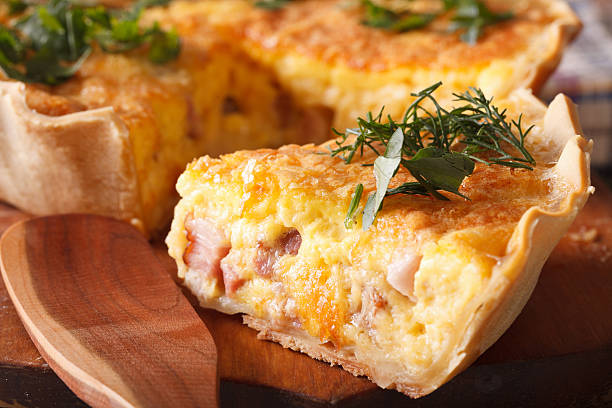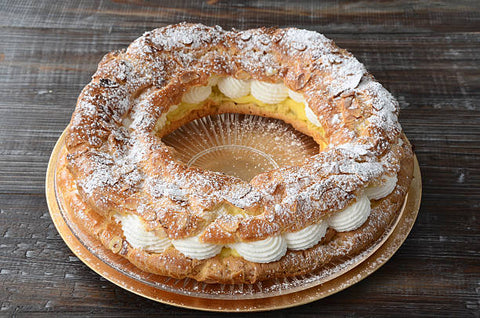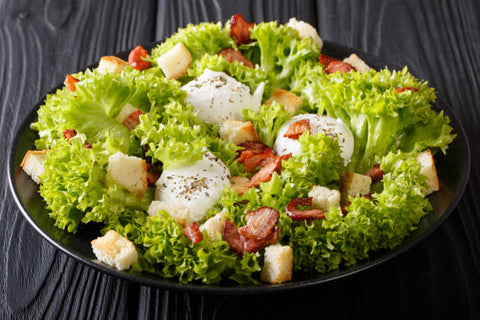Quiche Lorraine is a savory, open-faced pastry crust pie or tart filled with eggs and cheese, plus some meat (usually bacon or ham). Quiche originates from the French region of Lorraine.
Quiche Lorraine is one of the most common quiches made in France, and it's also a popular dish throughout Europe. In the United States, it's also one of the most famous quiches to make.
The best part about Quiche Lorraine is that it's technically easy to make. It can be served for breakfast, lunch, or dinner, making a great snack. Once you master this recipe, you can try out other variations using different meats and cheeses.
History of the Quiche
The history of quiche can be traced back to medieval times. Originally, it was a savory pie consisting of an egg and cream custard with bacon or salmon. The French word for cake is "quiche," which might have influenced the name.
The dish as we know it today originated in the Lorraine region of France in the 1800s. It consists of eggs and cream or milk in a pastry crust.
Difference between a Quiche and a Quiche Lorraine
- The basic difference between a quiche and a quiche Lorraine is the addition of bacon in a quiche Lorraine. A standard quiche could be made with many ingredients, but it is often just eggs, milk, and cheese. A quiche Lorraine contains bacon. Both are part of French cuisine, and both will usually have eggs and milk, along with cheese and the other ingredients that are added to them, depending on their flavor.
- Technically, quiche is a term for anything baked in the style of custard, but what we normally refer to as quiche is generally a variation of quiche Lorraine.
- Quiche Lorraine, which originated in the Alsace-Lorraine region of France, is an egg and cream custard baked in a pie crust with bacon or lardons. The recipe varies based on your area: Some versions use cheese (usually Gruyère), while others do not. Outside of France, quiches are commonly made with toppings like spinach, mushrooms, or onions.
- For example, quiche Florentine is made with spinach and Gruyère, and quiche au fromage contains only cheese (usually Emmental).
In short: Think of quiche Lorraine as the original version that all other variations are based on.
Why Quiche is called Lorraine?
Quiche is a savoury tart made with a pastry shell, usually open-faced, filled with eggs and milk or cream. The egg and milk mixture can be varied in various ways to make it more interesting.
Traditionally speaking, quiche Lorraine is one of the most popular versions. It's made with bacon (usually smoked), egg, and milk in an open pie crust. Other ingredients are sometimes added, such as cheese, onion, and spinach.
Lorraine is one of the 27 regions of France. This region borders Germany and Luxembourg, which may explain why quiche Lorraine has its roots in Germany, traditionally made with a yeast dough crust instead of the flaky pie crust used today.
Sometimes Quiche Lorraine become watery
Quiche Lorraine is a savory custard pie made with eggs and cream or milk. It's typically baked in a pastry crust and topped with bacon and cheese. When it comes out of the oven, you want to be able to cut a slice without making a mess. The last thing you want is for your quiche to be watery.
There are many reasons why this may happen, but most are related to the eggs and the filling.
- If the eggs aren't cooked enough:
Eggs are very sensitive to heat. They begin to set at 140 degrees and will continue to thicken as they approach 200 degrees Fahrenheit. A good rule of thumb is that each additional egg you add should increase the cooking time by 10 minutes, depending on what other ingredients you have in your quiche filling.
- If the eggs are overcooked:
The heat will continue to cook the eggs even after your quiche is removed from the oven, so it's important not to leave it in too long. So how do you know when it's done? A good test is to stick a knife into the center. If it comes out clean, your quiche is done; if batter clings to it, pop it back into the oven for another.
- There is some Liquid in the Quiche Lorraine:
It could be the cream or the eggs, or even the cheese. All of these ingredients have a certain amount of water in them. If you cook them too long or at too high a temperature, then water can come out.
- Try making your quiche with less cream and more eggs (the custard should be mostly egg). Try using a different brand of cream; various brands have different amounts of water in them. Use less cheese, or use a different kind of cheese with less water content.
Best Cheese to use for a Quiche Lorraine
It depends on what kind of quiche you're making and how you want the cheese to interact with the other ingredients.
- For example, if you're making a custard-based quiche (one with a crust but no sauce or roux), then a soft, mild cheese like mozzarella will melt nicely into your eggs and cream and will not overpower any other fillings. Sharp cheeses can be used in this context as well (try Gruyere or Emmental), but be aware that their strong flavors might detract from the rest of your filling.
If you're making a creamy quiche with a roux-based sauce, consider using a stronger cheese that will stand up to baking for longer periods. A fontina is often used, as are cheddar cheeses. In this situation, I would avoid anything too creamy or soft; if it melts too easily, it may absorb into the sauce too much and make it runny.
I love quiche, but I've always found the crust to be a pain in the rear. I'm not a baker, so everything from making the dough to rolling out the pie crust is a chore.
Enter the genius of this recipe by the bbcgoodfood:
- Use frozen phyllo dough as your crust instead! Phyllo is thinner and crispier than your run-of-the-mill pie crust, and it's already precut into perfectly sized sheets. It also doesn't get soggy like pie crust can when sitting for a while.
- This recipe has a lot of flexibility. You can make it with whatever veggies or meats you have on hand. Just saute them first, and then put them in the bottom layer of the pan before pouring in the egg mixture.
For cheese, I used Velveeta Queso Blanco cheese slices. They were super creamy and delicious, and they melt well so they were perfect for this dish!

What goes with Quiche Lorraine?
Quiche Lorraine is a simple, delicious dish perfect for breakfast, lunch, or dinner. There are many different ways to serve it, and it goes well with a lot of foods.
- Serve the quiche with a simple green salad tossed in oil and vinegar for an easy lunch or light supper. Or, for something more substantial, try a salad with a heartier green such as arugula or spinach tossed in your favorite dressing or vinaigrette. Add some sliced tomatoes and cucumbers, some croutons, and some shredded carrots if you like.
- For breakfast or brunch, add some fresh fruit salad to the plate along with the quiche. Or include some fresh berries in the greens salad mentioned above.
- Another idea is to include a small cup of soup before serving the quiche. Creamy soups such as cream of asparagus or cream of broccoli go well with quiche; avoid soups that are too spicy because they may overpower the delicate flavor of the quiche. If you prefer something heartier, try tomato soup, chicken noodle soup, or French onion soup instead.
If you are serving Quiche Lorraine at dinner, consider adding a side dish of whole grain rice or couscous seasoned with butter then try the recipe of cooking nytimes.
A good side dish for Quiche Lorraine
I would suggest a simple salad of greens and other crisp vegetables (depending on the season). A simple green salad with vinaigrette is also an excellent choice.
- If you want a more substantial side dish, you could think about doing a roast vegetable dish or pilaf. Anything that can be done before or finished in the oven while the quiche is baking is a good choice.
- Quiche is a great dish for entertaining because it is so versatile. It can be served hot, cold, or room temperature. You can make it as a main course or as a side dish. It can be dressed up or down to suit your occasion. And it can be made in advance and frozen for later use.
Quiche is traditionally served with a green salad and crusty French bread, but the sky is the limit when you start thinking of other options.
Here are some ideas:
- A simple green salad such as arugula tossed with an olive oil and lemon vinaigrette
- A fruit salad such as melon balls and sliced strawberries tossed with a minty lime dressing
- Potato salad using new potatoes and a mustard vinaigrette with fresh dill
- Creamy pasta salad with vegetables such as broccoli, carrots, and peas tossed in a basil-parsley vinaigrette
Today, quiche is most popularly known for its one main ingredient: cheese
The most common type of cheese used in quiche is Gruyere, but other types are often used. For example, some recipes call for Swiss cheese; others call for cheddar cheese or Parmesan cheese.
- When baking quiche, many people choose to use a pie dish because it's less messy than making individual servings on a cookie sheet.
- However, if you're looking to serve guests at your next gathering (or want something different), then you can use any container that's oven-safe and has an opening large enough to fit an uncooked pie crust over the top.
You could also opt for muffin tins if you don't have anything else available but make sure they're completely clean first so there's no risk.
Most popular types of quiche Lorraine
Quiche is a savory custard pie with a pastry crust and various ingredients, including meat, seafood, vegetables, and cheese. The term originated from the German word kuchen, which means cake.
There are three popular types of quiche:
1) Quiche Lorraine: The addition of bacon to this type of quiche makes it one of the most well-known varieties.
2) Quiche Alsacienne: This type of quiche originated in Alsace, France, and features onions and ham.
3) Vegetable Quiche: A healthy option made with spinach and parmesan cheese or asparagus and gruyere cheese.
Best wine goes with Quiche Lorraine
Quiche Lorraine is probably the most famous quiche, although there are many other popular versions. Ham and cheese are the traditional ingredients, but sometimes onions and mushrooms can be added.
Best wine with Quiche Lorraine by the lesgrappes:
- Pinot Noir
- Gamay
This is a classic dish with a strong flavor that needs a red wine to match it. So it's fortunate that the best wines to accompany it are extremely affordable. The budget-friendly Beaujolais, for example, which is made from the Gamay grape, is perfect for quiche as long as you avoid its more expensive cousin Beaujolais nouveau. But if you want to spend a little more, then pinot noir from Burgundy or California would be a good choice.
Quiche filling ideas
Here are a few ideas to get you started:
- Spinach and Feta Quiche
This classic quiche is made with spinach, feta cheese, and eggs. It's a simple recipe for an elegant breakfast or luncheon dish. Serve it with fresh fruit for a lovely brunch.
- Ham and Cheese Quiche
You can bake ham and cheese quiche ahead of time and refrigerate or freeze it for later use. This is a great recipe for holiday mornings -- warm it up in the microwave or oven while preparing the rest of the meal.
So the Quiche Lorraine is one of those classic dishes that can be enjoyed for breakfast, lunch, or dinner. However, Quiche Lorraine takes it to another level. You may have tried other versions of quiche before, but this dish will make you forget those other recipes that ever existed.
It's easy to make and only requires some basic ingredients and a single recipe. This makes it great for cooking when you're short on time or want something delicious.




